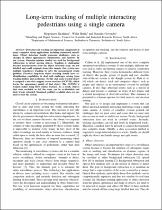JavaScript is disabled for your browser. Some features of this site may not work without it.
- ResearchSpace
- →
- Research Publications/Outputs
- →
- Conference Publications
- →
- View Item
| dc.contributor.author |
Keaikitse, M

|
|
| dc.contributor.author |
Brink, W

|
|
| dc.contributor.author |
Govender, Natasha

|
|
| dc.date.accessioned | 2015-03-12T09:49:13Z | |
| dc.date.available | 2015-03-12T09:49:13Z | |
| dc.date.issued | 2014-11 | |
| dc.identifier.citation | Keaikitse, M., Brink, W. and Govender, N. 2014. Long-term tracking of multiple interacting pedestrians using a single camera. In: PRASA, ROBMECH and AfLat International Joint Symposium, Cape Town, 27-28 November 2014 | en_US |
| dc.identifier.uri | http://www.prasa.org/index.php/2012-03-07-10-55-15 | |
| dc.identifier.uri | http://hdl.handle.net/10204/7907 | |
| dc.description | PRASA, ROBMECH and AfLat International Joint Symposium, Cape Town, 27-28 November 2014 | en_US |
| dc.description.abstract | Detection and tracking are important components of many computer vision applications including automated surveillance. Object detection should overcome challenges such as changes in object appearances, illumination, and shadows. In our system, Gaussian mixture models are used for background subtraction to detect moving objects. Tracking is challenging because measurements from the object detection stage are not labelled and could originate from false targets. Our system uses multiple hypotheses tracking to solve the measurement origin problem. Practical long-term object tracking should have re-identification capabilities to deal with challenges arising from tracking failure and occlusions. To this end, each tracked object is assigned a one-class support vector machine (OCSVM), which learns the appearance model of that object. The OCSVM is trained online using HSV colour features. As a result, objects that were occluded or left the scene can be re-identified and their tracks extended. Standard, publicly available data sets are used to test the system. | en_US |
| dc.language.iso | en | en_US |
| dc.publisher | PRASA | en_US |
| dc.relation.ispartofseries | Workflow;13967 | |
| dc.subject | Object detection | en_US |
| dc.subject | Background subtraction | en_US |
| dc.subject | Tracking | en_US |
| dc.subject | Support vector machine | en_US |
| dc.title | Long-term tracking of multiple interacting pedestrians using a single camera | en_US |
| dc.type | Conference Presentation | en_US |
| dc.identifier.apacitation | Keaikitse, M., Brink, W., & Govender, N. (2014). Long-term tracking of multiple interacting pedestrians using a single camera. PRASA. http://hdl.handle.net/10204/7907 | en_ZA |
| dc.identifier.chicagocitation | Keaikitse, M, W Brink, and Natasha Govender. "Long-term tracking of multiple interacting pedestrians using a single camera." (2014): http://hdl.handle.net/10204/7907 | en_ZA |
| dc.identifier.vancouvercitation | Keaikitse M, Brink W, Govender N, Long-term tracking of multiple interacting pedestrians using a single camera; PRASA; 2014. http://hdl.handle.net/10204/7907 . | en_ZA |
| dc.identifier.ris | TY - Conference Presentation AU - Keaikitse, M AU - Brink, W AU - Govender, Natasha AB - Detection and tracking are important components of many computer vision applications including automated surveillance. Object detection should overcome challenges such as changes in object appearances, illumination, and shadows. In our system, Gaussian mixture models are used for background subtraction to detect moving objects. Tracking is challenging because measurements from the object detection stage are not labelled and could originate from false targets. Our system uses multiple hypotheses tracking to solve the measurement origin problem. Practical long-term object tracking should have re-identification capabilities to deal with challenges arising from tracking failure and occlusions. To this end, each tracked object is assigned a one-class support vector machine (OCSVM), which learns the appearance model of that object. The OCSVM is trained online using HSV colour features. As a result, objects that were occluded or left the scene can be re-identified and their tracks extended. Standard, publicly available data sets are used to test the system. DA - 2014-11 DB - ResearchSpace DP - CSIR KW - Object detection KW - Background subtraction KW - Tracking KW - Support vector machine LK - https://researchspace.csir.co.za PY - 2014 T1 - Long-term tracking of multiple interacting pedestrians using a single camera TI - Long-term tracking of multiple interacting pedestrians using a single camera UR - http://hdl.handle.net/10204/7907 ER - | en_ZA |






